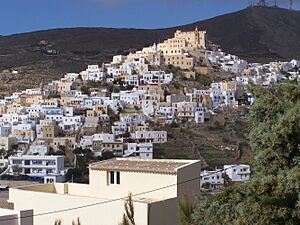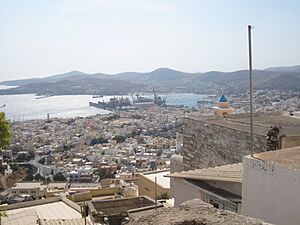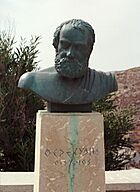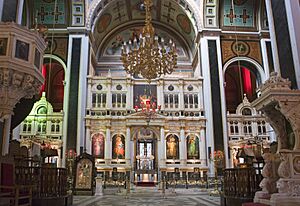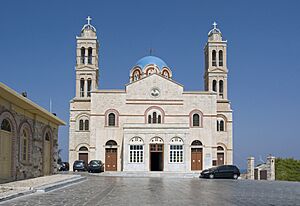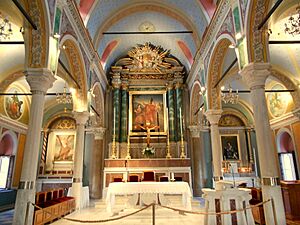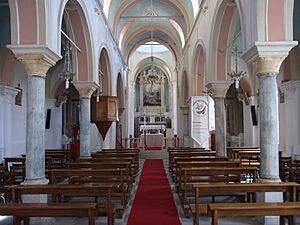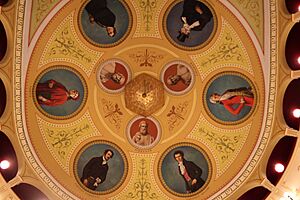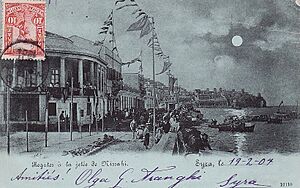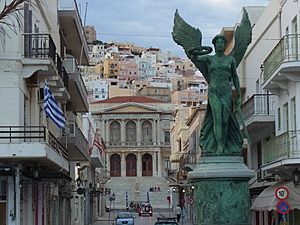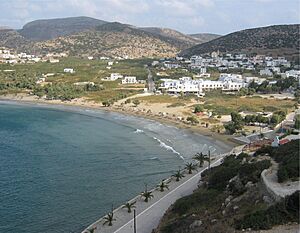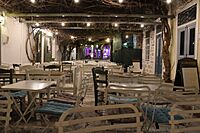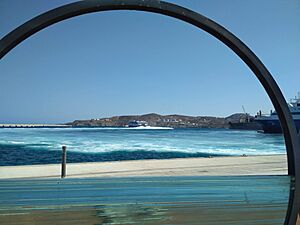Syros facts for kids
Quick facts for kids
Syros
Περιφερειακή ενότητα Σύρου
Δήμος Σύρου-Ερμούπολης |
|
|---|---|

Ermoupoli and Ano Syros
|
|
| Country | Greece |
| Administrative region | South Aegean |
| Area | |
| • Total | 101.9 km2 (39.3 sq mi) |
| Population | |
| • Total | 21,124 |
| • Density | 207.30/km2 (536.91/sq mi) |
| Time zone | UTC+2 (EET) |
| • Summer (DST) | UTC+3 (EEST) |
| Postal code |
841 xx
|
| Area code(s) | 228x0 |
| Vehicle registration | EM |
Syros (Greek: Σύρος [ˈsiros]), also called Siros or Syra, is a beautiful Greek island. It is part of the Cyclades island group in the Aegean Sea. Syros is about 78 nautical miles (144 km) south-east of Athens, the capital of Greece. The island covers an area of 83.6 km2 (32 sq mi). In 2021, about 21,124 people lived there.
The biggest towns on Syros are Ermoupoli, Ano Syros, and Vari. Ermoupoli is the main city of the island. It is also the capital for the whole Cyclades region and the South Aegean area. Ermoupoli has always been an important port. In the 1800s, it was even more important than Piraeus, which is a big port near Athens today. Other smaller villages on Syros include Galissas, Foinikas, Pagos, Manna, Kini, Azolimnos, and Poseidonia.
Contents
Ermoupoli: The Capital City

Ermoupoli (Greek: Ερμούπολη) is built on a hillside, like an amphitheater. Its buildings, including old mansions and white houses, seem to flow down towards the harbor. The city was built in the 1820s during the Greek War of Independence.
The city hall is in the center of Ermoupoli, in a place called Miaoulis Square. This square is surrounded by cafes, seating areas, and palm trees. Ermoupoli is sometimes called the "City of Hermes". It has many churches, such as Metamorphosis, Koimisis, St. Demetrius, Three Hierarchs, Anastasis, Evangelistria, and St. Nicolas. You can also find an archaeological museum and a public library here.
The area known as Vaporia was traditionally where sea captains lived. This part of the city has many beautiful neo-classical mansions along its narrow streets.
Ano Syros: A Medieval Town
Ano Syros is the second largest town on the island. It was built by the Venetians in the early 1200s. It sits on the hill of San Giorgio, to the north-west of Ermoupoli. Ano Syros still feels like a town from the Middle Ages. Many steps wind through narrow streets and houses with colorful doors, leading up to the top of the town.
You can reach Ano Syros by car, but most of the town is explored on marble steps. The main entrance to the town is about 1,000 meters from the harbor. The Catholic cathedral of Saint George stands proudly at the top of Ano Syros. This church was built in the 1200s. From the cathedral, visitors can enjoy amazing panoramic views of nearby islands like Tinos, Delos, Mykonos, Paros, Andros, and Naxos.
Syros Through Time
Ancient Beginnings
The story of people living on Syros goes back at least 5,000 years. This was during the Early Bronze Age of the Cycladic civilization. At this time, a settlement called Kastri began on a hilltop. Archaeologists call the culture from this time the Kastri culture. It had connections with trade networks in Asia Minor.
Kastri, which dates from 2800-2300 BC, was one of the first settlements in Greece to be protected by stone walls with rounded towers. The cemetery of Chalandriani is also linked to Kastri. Inside the walls, houses were built very close together, sharing walls. It is thought that up to 300 people lived in this fortified town.
The site was first found and dug up in 1898 by Christos Tsountas. He is known as the "father of Cycladic research." Kastri also shows some of the earliest metalwork in the area. It also has some of the earliest examples of using a potter's wheel.
Old Greek and Roman Times
In ancient times, the island was known as Syra (Ancient Greek: Σύρα), and later Syros or Siros (Σῦρος). It seems that the Phoenicians lived here later on. In the famous story of the Odyssey, Syros is described as the home of the swineherd Eumaeus.
The island was also home to the philosopher Pherecydes. He was the teacher of the famous mathematician Pythagoras. Syros had two main cities back then: Syros (where modern Ermoupoli is) and another city called Galessus on the western coast, where Galissas is now.
Syros was not a very important island during ancient Greek and Roman times or in the early years of Christianity. It didn't even have its own bishop, even when smaller islands did. During Roman times, the capital of Syros was in the area where Ermoupoli is today.
The Middle Ages
Towards the end of ancient times, attacks by barbarians and piracy caused Syros to decline. These attacks affected the Aegean for many centuries. Syros, like other Cycladic islands, was destroyed several times during the Middle Ages. Raiders came from different places, including Sicily, Arabs, Turks, and Venetians.
During the Byzantine years, Syros was part of the Theme of the Aegean Sea. This was a military and administrative area that included the Cycladic islands. After the Fourth Crusade in 1204, when the Venetians and Franks took over Byzantium, the Venetians finally conquered Syros. This happened under the leadership of Marco Sanudo. Syros remained under Venetian rule as part of the Duchy of the Archipelago until 1566. However, after 1540, they had to pay tribute to the Ottoman Sultan to keep control.
This was when Ano Syros was founded. During the Latin period, most local people were Roman Catholic. But they still spoke the Greek language. For almost 350 years under the Duchy of the Archipelago, Syros had a special feudal system.
Ottoman Rule
By the 1500s, the Ottoman fleet became very strong in the Aegean Sea. The Duchy of the Archipelago fell apart. In 1522, the pirate Barbarossa took control of the island. During Ottoman rule, it was known as "Sire." However, local leaders talked with the Ottomans. They managed to get special rights for the Cyclades islands. These rights included lower taxes and religious freedom.
At the same time, France and the Holy See (the Pope's government) made an agreement with the Ottoman leaders. This meant that the Catholics on the island were protected by France and Rome. Because of this, Syros was sometimes called "the Pope's island."
The Roman Catholic diocese of Syros was a Catholic church area. It was under the Latin Archbishopric of Athens until 1525. When the Turks took over the island in the 1500s, the Greeks set up an Orthodox metropolitan on Syros. Joseph is the earliest known, followed by Symeon (who died in 1594) and Ignatius (in 1596). The island became mostly Catholic.
One important Catholic bishop was Ioannis Andreas Kargas. The Turks cruelly killed him in 1617. He refused to convert to Islam and helped Greek rebels hiding on the island.
After the mid-1600s, the Aegean region began to recover economically. This reached its peak around the late 1700s and early 1800s. The special rules for the islands allowed local self-government to grow. Piracy also decreased from the early 1800s. This made sea routes in the Eastern Mediterranean safer.
Syros in Independent Greece
The 1800s: A New Beginning
Because of its important location, Syros became a key stopping point for ships. Also, the island's special social, religious, and political situation led the people of Syros to stay neutral at the start of the Greek War of Independence in 1821. This meant Syros became a safe place during the war. Many Greek refugees came here from places like Asia Minor, Chios, Spetses, Psara, Aivali, Smyrna, Kydonia, and Kassos. These refugees were the ones who built Ermoupoli.

In 1827, Syros became part of the new First Hellenic Republic. Later, in 1834, it joined the Greek Kingdom. The island became peaceful again. Syros became known as a crossroads in the Aegean and a global trading center. It connected Western Europe and the Mediterranean Sea to the East. The first buildings were constructed in 1822. In 1824, the first Orthodox Church, Metamorphosis, and the largest Greek hospital were built.
Because the Venetians ruled for a long time, most islanders were Roman Catholic. However, many people moved to Syros from other islands. Now, about 47% of the population is Catholic. Most people are Greek Orthodox. It is very common for people from different churches to marry in Syros. There is also one church that belongs to the Byzantine Greek Catholic Church.
In 1831, Syros played a big part in creating the new Greek Constitution. Under Ioannis Kapodistrias, the first Governor of the new Greek state, Ermoupoli's population reached 13,805 people. The city became an important government center.
It had a Commercial Court, one of Greece's first post offices, insurance companies, the first public school, a branch of the National Bank of Greece, an art gallery, a museum, a library, and a social club for important people. However, in 1854, a cholera outbreak and other diseases caused many deaths in Syros. During this time, several charitable groups were set up to help with public health and social services. These included orphanages, poorhouses, and a mental hospital.
New people, mainly sailors and traders, brought new energy to the island. This, along with its growing population and economy, made Syros an important administrative and cultural center. Newcomers flocked to the island and founded Ermoupoli. It quickly became the most important port in Greece.
Between 1822 and 1865, Ermoupoli was rebuilt in a Neoclassical style. This style mixed Greek Classicism with ideas from the Renaissance. Many famous buildings were constructed then. These include the City Hall (designed by German architect Ernst Ziller), the Apollo Theatre by Italian architect Pietro Campo (a smaller version of the La Scala in Milan), the main Library, the General Hospital of Syros, Miaoulis Square, and other buildings. The English artist Edward Lear visited in 1864 and called the town "the old sparkly pile" because of all its beautiful marble.
European architects (mostly Germans and Italians) and Greek architects helped design and plan Ermoupoli. They respected classical and ancient Greek architecture. They also blended it with the romanticism of the West. Ermoupoli has many neoclassical buildings. The success of Syros was linked to its social and cultural growth. The island's development was completed with the creation of its first factories in the 1860s and 1870s.
Most public buildings, churches, schools, stadiums, and many mansions were built in the same elegant neoclassical style. This made Ermoupoli a very modern city with a unique look at the time. As a result, Syros quickly changed from a quiet island into a busy center for crafts, industry, and production. Also, because of its large port, Ermoupoli became a major center for building and repairing ships. Neorion was Greece's first shipyard. Even today, many ships are serviced and repaired there.
From 1830, trade in fabrics, silk, shipbuilding, leather, and iron grew on Syros. At the same time, a strong banking system was created. Ermoupoli continued to grow rapidly. Until 1860, Syros was the most important commercial harbor in Greece. Along with trade and shipbuilding, construction and public works also developed. The Greek Steamship Company was founded in 1856.
Then, a period of decline followed. Sailing ships were replaced by steamships. The island's important geographical location became less critical. The port of Piraeus finally became the main port in Greece. Competition from Patras also reduced Syros's trading importance.
The 1900s and Today
At the end of the 1800s and for several decades, the economy improved for a while. This was due to the growth of the textile industry.
During World War II, Italy, led by Benito Mussolini, invaded and occupied Syros. The people on the island suffered a terrible famine, and thousands died.
The Second World War slowed down Syros's economic growth, just like it did for other economic centers in Greece. However, since the 1980s, the economy has recovered, and living standards in Greece have improved. Syros has also started to improve, with tourism becoming very important. The re-opening of the Neorion shipyards and other activities show that Syros is growing again.
Today, Ermoupoli has 7 elementary schools, 2 junior high schools, 2 high schools, and 2 technical schools. It also has a branch of the Aegean University with departments for Fine Arts and system design. There are plans to add more art-related programs in the future. The Syros Island National Airport, the Aegean casino, and frequent boat services help bring many Greek and foreign tourists to the island all year round.
Syros also has a British cemetery. Many sailors and service members who died in the Cyclades region, especially during World War II, are buried there. The many consulates from countries like France, Britain, Italy, the Netherlands, and Scandinavian countries show how connected Syros is to the wider European world.
Island Administration
Syros is its own regional unit within the South Aegean region. The only municipality in this regional unit is Syros-Ermoupoli. This municipality was created in 2011 as part of a government reform. It was formed by combining three older municipalities:
- Ermoupoli
- Ano Syros
- Poseidonia
The municipality also includes the uninhabited island of Gyaros and several other small islands. The total area of the municipality is 101.90 km2 (39 sq mi).
Religion on Syros
Like the rest of Greece, Syros has Eastern Orthodox churches. Metamorphosis is the most important Orthodox church on the island. Kimisis tis Theotokou is also significant because it has a famous painting by El Greco. There are also many Catholic Church buildings on the island, and some villages are entirely Catholic. This makes Syros a very important place for the Catholic Church in Greece. Syros is one of the few places where Catholics and Orthodox Christians celebrate Easter on the same date, which is the Orthodox date.
The Catholic diocese on Syros has about 9,000 members. It has 21 secular priests and 8 regular priests. There are 7 parishes, 7 churches with a priest, 3 without a priest, and 57 chapels. The Capuchins and Jesuits each have a presence. The Sisters of Charity have two houses, one of which is a hospital. The Sisters of St Joseph of the Apparition run a boarding school and St George, a De La Salle Public School.
There is also one church of the Greek Byzantine Catholic Church. This church is not part of the main diocese but is under the Byzantine Exarchate of Greece.
Local Food
Here are some special foods you can try on Syros:
- Kaparosalata (a salad made with capers)
- Maidanosalata (a salad with parsley)
- Frisoura (an appetizer)
- Delagraciano
- Ladopita
- Marathopita
- Tomatokeftedes (fried tomato balls)
- Kalamari gemistó (stuffed grilled squid)
- Sfougato
- San Michali cheese
- Loukoumi (a sweet dessert)
- Halvadopita (another sweet dessert)
- Pastelaria (dried figs dessert)
Sports on Syros
- Foinikas Syros V.C. (volleyball team)
- Aris Syros (basketball and volleyball)
- Hellas Syros (football)
- Athletic Club Syros (basketball and football)
- Syros Windsurfing School
- Komito Watersports
Syros Airport
Famous People from Syros
- Eumaeus: A character from the ancient Greek story, the Odyssey.
- Pherecydes (around 600–550 BC): A famous philosopher.
- Ioannis Andreas Kargas: A Catholic bishop of Syros and a martyr.
- Michail Melas (1833–1897): A Greek politician and merchant.
- Demetrius Vikelas (1835–1908): A writer and the first president of the International Olympic Committee.
- Emmanuel Roidis (1836–1904): A writer and journalist.
- Stamata Revithi (1866–?): The first woman to compete in the Olympic Games and run the Marathon.
- Antonio Gregorio Vuccino (1891–1968): An Archbishop in Greece.
- Anna Kalouta (1918–2010): A well-known actress.
- Markos Vamvakaris (1905–1972): A famous musician.
- Rita Boumi-Pappa (1906–1984): A poet and translator.
- Anargyros Printezis: A bishop and leader of the Byzantine Rite Catholics in Greece.
- Olga Broumas (1949–): A poet and translator.
- Stelios Mainas (1957–): An actor.
- Georgios Printezis (1985–): A professional basketball player.
Images for kids
-
Statue of Andreas Miaoulis
See also
 In Spanish: Siros para niños
In Spanish: Siros para niños



